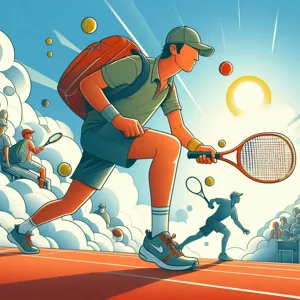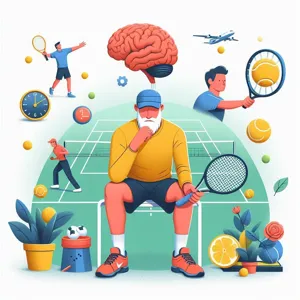Golf is as much about the mind as it is about the mechanics, and mastering your swing is the key to unlocking your full potential on the course.
Whether you’re a seasoned golfer looking to refine your technique or a beginner eager to establish a solid foundation, achieving the perfect rhythm and consistency in your swing can transform your game. In this blog post, we’ll delve into essential tips and strategies designed to enhance your swing, focusing on the harmony between timing, body movement, and mental focus. From understanding the fundamentals of grip and stance to incorporating drills that promote muscle memory, you’ll discover how to develop a fluid, repeatable swing that not only lowers your scores but also makes each round more enjoyable. Join us as we explore the art and science of the golf swing, and prepare to take your game to new heights!
1. Understanding the Importance of Rhythm in Golf

Rhythm is the heartbeat of a powerful and consistent golf swing. Just as a musician relies on a steady tempo to create harmonious melodies, a golfer must cultivate a smooth and rhythmic swing to achieve optimal performance on the course. When you think of rhythm in golf, picture the fluidity of a pendulum—a seamless back-and-forth motion that creates a natural flow, allowing for precision and control.
The importance of rhythm cannot be overstated. It serves as the foundation for timing, which is critical in executing a successful swing. A golfer who possesses a keen sense of rhythm can better synchronize their body movements, ensuring that each part of the swing—back swing, transition, and follow-through—connects effortlessly. This synchronization reduces tension and promotes a more relaxed stance, allowing for greater focus and improved shot accuracy.
Moreover, establishing a consistent rhythm helps mitigate the influence of external factors that can disrupt a golfer’s game, such as nerves or distractions on the course. When you have a reliable rhythm, you can trust your body to perform instinctively, rather than overthinking each movement. This mental clarity translates into more confident swings and better overall performance.
To harness the power of rhythm, spend time honing your awareness of your natural swing tempo. practice drills that emphasize the importance of maintaining a steady beat, whether through counting, using a metronome, or even syncing your swings with music. By integrating rhythm into your practice routine, you’ll unlock a new level of consistency that can elevate your game and make each round a more enjoyable experience. Remember, golf is as much about the mind as it is about the mechanics; embracing the rhythm of your swing can be the key to mastering the course.
2. The Role of Consistency in a Successful Golf Swing
Consistency is the bedrock of a successful golf swing, serving as the invisible thread that weaves together the various elements of your technique. When golfers hear the term “consistency,” they often think of hitting the ball the same way every time, but it goes much deeper than that. It’s about developing a reliable rhythm, a repeatable motion, and a mental approach that allows you to trust your swing, even under pressure.
Imagine stepping up to the tee, knowing exactly how your body will move and how the club will respond. This feeling of certainty is born from consistent practice and a solid understanding of your swing mechanics. Each component—your grip, stance, posture, and follow-through—must work in harmony to create a fluid motion. When these elements align, your swing becomes a symphony of precision, and you’ll find that your ball flight is not just predictable, but also powerful.
To cultivate this consistency, focus on establishing a routine that you can adhere to during each round. Whether it’s a specific pre-shot routine or a mental mantra you repeat before every swing, having a set process helps to eliminate the variables that can lead to inconsistency. Additionally, recording your practice sessions allows you to identify patterns and areas for improvement. By analyzing your swings, you can make subtle adjustments that enhance your overall rhythm.
In the end, the goal is not just to swing the club the same way every time, but to create a reliable performance that allows you to enjoy the game. When you achieve consistency, you not only lower your scores but also boost your confidence on the course. So, invest the time to master the fundamentals, and watch as the precision of your swing transforms your golfing experience. With each practice session, you’ll be one step closer to making consistency an integral part of your golfing identity.
3. Analyzing Your Current Swing: Identifying Strengths and Weaknesses

To truly master your golf swing, you must first take a critical look at your current technique. Analyzing your swing involves more than just observing the mechanics; it requires a deep understanding of your individual strengths and weaknesses. This self-assessment can significantly enhance your rhythm and consistency on the course.
Start by recording your swing from various angles—down the line, face-on, and even slow-motion shots. Watching your swing unfold in real time allows you to pinpoint key aspects, such as your grip, stance, and follow-through. Are your feet planted firmly, or do they shift during the swing? Is your weight distribution balanced, or do you tend to lean too much on your back foot? These observations can reveal critical insights into how your body moves throughout the swing.
Next, consider using technology to your advantage. Tools like swing analysis apps or motion sensors can provide data on club speed, angle of attack, and swing path. By comparing this data against your goals or professional benchmarks, you can identify areas that require improvement. For instance, if your swing path is consistently outside-in, it may lead to slices, while an inside-out path could produce hooks. Recognizing these tendencies is the first step toward making the necessary adjustments.
Seek feedback from experienced golfers or instructors who can provide a fresh perspective. Sometimes, an outside eye can catch nuances in your swing that you may overlook. They might notice that your takeaway is too abrupt or that your finish lacks balance. Constructive criticism can guide your practice sessions, allowing you to focus on specific areas that need attention.
Finally, keep a journal of your findings. Document the aspects of your swing that feel strong and those that need work. This not only tracks your progress over time but also reinforces your commitment to improvement. By regularly revisiting and analyzing your swing, you’ll cultivate a deeper awareness of your technique, ultimately enhancing your rhythm and consistency as you master the art of the golf swing.
4. Key Fundamentals of a Strong Golf Swing
To master your golf swing, understanding and implementing the key fundamentals is essential. A strong golf swing is not merely the result of brute force; it is a delicate dance of precision, timing, and technique. Here are the foundational elements you should focus on to enhance your rhythm and consistency on the course.
**Grip:** Your grip is the connection between you and the club. A proper grip allows you to control the clubface, which is crucial for accuracy. The most common grips include the overlapping, interlocking, and ten-finger grips. Whichever grip you choose, ensure that it feels comfortable and allows you to maintain control throughout your swing.
**Posture:** A solid stance begins with good posture. Stand with your feet shoulder-width apart, knees slightly bent, and your back straight. Your arms should hang naturally from your shoulders, and your weight should be balanced on the balls of your feet. This athletic stance not only promotes stability but also sets the stage for a fluid swing.
**Alignment:** Proper alignment is often overlooked but is vital for directing your shots accurately. Aim your body parallel to the target line, with your feet, hips, and shoulders all aligned. Use an intermediate target—a spot a few feet in front of your ball—to help guide your alignment. This simple step can significantly improve your accuracy.
**Swing Plane:** The swing plane refers to the path your club travels during the swing. Ideally, it should follow a consistent arc that allows for a natural motion. To achieve this, focus on keeping your lead arm straight while maintaining a relaxed wrist. Visualization can help: imagine the club traveling along a plane that is parallel to your stance.
**Follow-Through:** A strong follow-through is often a reflection of a well-executed swing. It indicates that you have maintained balance and control throughout the motion. As you complete your swing, allow your body to rotate toward the target, finishing with your weight shifted onto your front foot. A complete follow-through not only improves your shot distance but also reinforces good habits for future swings.
By honing in on these key fundamentals, you will build a solid foundation that enhances your rhythm and consistency on the golf course. Remember, mastering your swing is a journey that requires patience and practice, so focus on these elements, and soon you will notice significant improvements in your game.
5. Developing a Pre-Swing Routine for Better Focus

A well-crafted pre-swing routine can be the difference between a successful shot and one that misses the mark. It serves as your mental and physical warm-up, preparing both your body and mind for the task at hand. Think of it as a ritual that not only calms your nerves but also fosters consistency in your performance.
Begin by identifying the elements of your routine. This could include a few practice swings, a deep breath to center yourself, or a mental visualization of the shot you want to execute. The key is to find a sequence of actions that helps you feel relaxed and focused before you take your shot. For instance, you might start with a brief stretch to loosen up your muscles, followed by a visual scan of the hole or target you’re aiming for. Then, take a moment to visualize the ball’s trajectory as you stand behind the ball, imagining the perfect swing that will send it soaring.
Consistency is crucial in golf, and a pre-swing routine not only sets the stage for your shot but also creates a sense of familiarity. Over time, as you repeat your routine, your body will begin to recognize the cues, helping to ease tension and build confidence. Just like a musician practicing scales before a performance, your routine becomes a form of preparation that tunes your mind and body into the rhythm of the game.
Remember, your pre-swing routine should be personal and adaptable. What works for one golfer might not work for another. Take the time to experiment with different elements and find what resonates best with you. The ultimate goal is to cultivate a state of focused calm that will carry through into your swing, allowing you to strike the ball with both precision and power. By investing in this simple yet effective practice, you can enhance your focus, improve your rhythm, and elevate your overall performance on the course.
6. Drills to Improve Your Rhythm and Timing
Improving your golf swing requires more than just understanding the mechanics; it demands a keen focus on rhythm and timing. Drills designed to enhance these aspects can be transformative, helping you to develop a smooth, consistent swing that translates to better performance on the course. Here are a few effective drills to incorporate into your practice routine:
**1. The Metronome Drill:** One of the simplest yet most effective ways to improve your rhythm is to use a metronome. Set it to a comfortable tempo that suits your swing speed—typically between 60 to 80 beats per minute. As you practice your swing, synchronize your movements to the beat, ensuring your backswing and downswing flow together seamlessly. This drill helps you establish a natural rhythm, reducing the likelihood of rushed or jerky movements.
**2. The One-Handed Swing Drill:** This drill emphasizes timing and balance. Begin by practicing your swing with just your lead hand (left hand for right-handed golfers, right hand for left-handed golfers). Focus on maintaining control and smoothness in your swing. After several repetitions, switch to your trailing hand. This will help you feel the weight of the club and understand the importance of a balanced swing. Gradually increase the tempo as you become more comfortable, ensuring that your timing remains intact.
**3. The Slow Motion Drill:** Slow down your swing to a crawl. This might feel awkward at first, but it allows you to concentrate on each component of your swing. Pay attention to your stance, grip, and the transition from the backswing to the downswing. This drill helps to reinforce proper mechanics and build muscle memory, ultimately leading to a more consistent swing when you return to your normal pace.
**4. The Pause at the Top Drill:** To develop better timing, take a moment to pause at the top of your backswing. This brief halt allows you to gather your thoughts and prepare for the transition into your downswing. When you finally move, focus on initiating the downswing with your lower body, followed by your upper body and arms. This drill will enhance your sequencing, promoting a smoother and more powerful swing.
By incorporating these drills into your practice sessions, you will cultivate a greater sense of rhythm and timing in your golf swing. Consistency will follow, allowing you to approach the course with confidence and precision. Remember, mastering your swing is a journey, and these drills are invaluable tools in your quest for improvement.
7. The Influence of Grip Pressure on Your Swing

When it comes to mastering your golf swing, the subtle art of grip pressure is often overlooked, yet it holds significant sway over your rhythm and consistency. Imagine holding a delicate glass, the kind that might shatter with too tight a grasp—this is akin to how you should approach your grip on the golf club. Excessive grip pressure can lead to tension in your hands, arms, and shoulders, which disrupts the fluidity of your swing and can cause erratic shots.
Conversely, a grip that is too loose may result in a lack of control, leading to mishits and lost distance. The key lies in finding that sweet spot—the balance between firm control and relaxed fluidity. A good rule of thumb is to maintain a grip pressure that feels like you’re holding a bird. Firm enough to keep it from flying away, but gentle enough not to cause harm.
To fine-tune your grip pressure, practice is essential. Spend time on the driving range experimenting with different pressures. Pay attention to how each variation affects the trajectory and distance of your shots. Incorporate drills that focus on muscle memory to help you achieve that ideal grip pressure consistently.
As you develop a better understanding of how grip pressure influences your swing, you’ll find that it not only enhances rhythm but also builds a foundation for greater consistency. The more you practice with a mindful approach to your grip, the more natural it will become, paving the way for a smoother, more effective golf swing. Remember, mastery is in the details, and the right grip pressure can make all the difference on the course.
8. The Importance of Balance and Posture
Achieving a proper golf swing starts long before the club meets the ball; it hinges significantly on two foundational elements: balance and posture. Your stance sets the stage for rhythm and consistency, acting as the bedrock upon which your entire swing is built.
Imagine stepping up to the tee. The way you position your feet, the alignment of your shoulders, and the angle of your back all contribute to a stable setup. A balanced stance creates a solid base, allowing you to pivot smoothly and transfer your weight effectively during the swing. When your weight is correctly distributed, you can swing with confidence, knowing that you won’t lose your footing mid-shot.
Posture is equally critical. Maintaining a straight back while slightly bending at the hips helps to create a natural and athletic stance. This balanced posture enables you to rotate your upper body fluidly, generating power and speed without sacrificing control. Additionally, a proper grip that aligns with your posture can enhance your swing’s consistency, leading to better shot accuracy.
To hone your balance and posture, consider incorporating specific exercises into your practice routine. Simple drills, such as practicing your swing with your feet close together or engaging in stability exercises like single-leg balances, can significantly improve your overall stability. Furthermore, spending time in front of a mirror or recording your swing can help you visually assess and adjust your posture, ensuring you maintain the ideal stance.
Ultimately, mastering balance and posture is not just about looking good on the course; it’s about setting yourself up for success with every swing. With a solid foundation, you’ll find your rhythm more easily, allowing for greater consistency and, ultimately, better performance on the greens.
9. Using Visualization Techniques to Enhance Performance
Visualization techniques can be a powerful tool in your quest to master the perfect golf swing. This mental practice allows you to create vivid, detailed images of your ideal swing and desired outcomes before stepping onto the course. By harnessing the power of your imagination, you can enhance not only your rhythm but also your overall performance.
Start by finding a quiet space where you can focus without distractions. Close your eyes and take a few deep breaths to center yourself. Imagine standing on the tee, feeling the weight of the club in your hands. Visualize every aspect of your swing in intricate detail—the stance, the grip, the smooth rotation of your hips, and the arc of your arms as they guide the club through the ball. Picture the ball soaring through the air, landing exactly where you want it to.
Incorporate this technique into your practice routine, dedicating a few minutes before each session to mentally rehearse your swing. Research shows that mental practice can enhance muscle memory and improve focus, making it just as important as physical practice. When you visualize, you’re not just daydreaming; you’re training your brain to respond in a specific way, which can lead to more consistent execution on the course.
Additionally, consider using visualization to prepare for various scenarios you might face while playing. Whether it’s a challenging putt on the 18th hole or navigating a tricky bunker shot, envisioning yourself successfully overcoming these challenges can boost your confidence and reduce anxiety.
By regularly integrating visualization techniques into your training, you’ll cultivate a stronger connection between your mind and body, leading to greater rhythm and consistency in your golf swing. Over time, this mental rehearsal will become second nature, allowing you to step onto the course with a clear mind and a focused intent, ready to take your game to the next level.
10. Incorporating Tempo Training Tools
In the pursuit of a more fluid and consistent golf swing, incorporating tempo training tools can be a game-changer. These innovative devices are designed to help you develop a sense of timing and rhythm that is crucial for achieving a powerful yet controlled swing. From metronomes to specialized training aids, these tools can provide the feedback and structure necessary for fine-tuning your swing mechanics.
One popular option is the use of a metronome, which allows you to set a specific tempo that you can practice to. By syncing your swing to the beat, you can establish a consistent rhythm that translates into better timing on the course. Start by setting the metronome to a slow pace, focusing on the smoothness of your backswing and follow-through. Gradually increase the tempo as you become more comfortable, allowing your body to adapt to the rhythm.
Another effective tool is the use of swing trainers, which come in various forms, including weighted clubs and resistance bands. These devices not only help strengthen the muscles used in your swing but also promote a more consistent tempo by forcing you to slow down and focus on your form. For instance, using a weighted club during practice can help you feel the proper swing mechanics while developing a sense of rhythm that will carry over to your regular clubs.
Additionally, consider integrating video analysis into your training regimen. Recording your swings and analyzing them with tempo training software can provide invaluable insights into your rhythm and timing. Observing your swing in slow motion allows you to pinpoint areas for improvement, ensuring that you are not only hitting the ball effectively but also doing so with a consistent tempo.
By incorporating these tempo training tools into your practice routine, you’ll not only enhance your rhythm but also build the consistency that is essential for lower scores. The more you can internalize a smooth, rhythmic swing, the more confident you’ll feel on the course, ultimately leading to improved performance and enjoyment of the game.
11. Practicing with Purpose: Setting Specific Goals
Practicing with purpose is a game-changer for golfers looking to enhance their rhythm and consistency. Instead of mindlessly hitting balls at the driving range, setting specific, measurable goals can transform your practice sessions into effective learning experiences. Begin by identifying areas of your game that need improvement—be it your drive, iron play, or putting—and then create targeted objectives around them.
For instance, if you struggle with your driver, set a goal to hit a certain percentage of fairways during a practice session. This could mean focusing on technique, such as your grip or stance, and then counting how many successful shots you make. Alternatively, you might aim to improve your chipping by practicing different lies and distances, challenging yourself to get up and down a specific number of times in a row.
To make your practice even more purposeful, consider incorporating drills that emphasize rhythm and consistency. Use alignment sticks to ensure proper setup, or record yourself swinging to analyze your form and tempo. Additionally, don’t shy away from setting time constraints. For example, give yourself 30 minutes to complete a series of targeted drills, which not only helps develop a sense of urgency but also simulates the pressure of an actual round.
Remember to periodically reassess your goals. As you improve, your objectives should evolve to keep pushing your skills further. By practicing with purpose and clarity, you’ll not only enhance your rhythm and consistency but also build a more enjoyable and rewarding golfing experience.
12. The Impact of Mental Game on Swing Consistency
When it comes to mastering your golf swing, the importance of the mental game cannot be overstated. In fact, the mental elements of golf often play a more pivotal role in determining your swing consistency than physical technique alone. Every golfer knows that the game is as much about strategy and focus as it is about strength and skill. The mind can be a powerful tool, but it can also be a source of distraction and doubt, which can severely affect your performance on the course.
One of the key aspects of a strong mental game is visualization. Before stepping up to take a shot, visualize the ball’s trajectory and the perfect landing spot. This mental rehearsal can help align your focus, boosting your confidence and enhancing your ability to execute the swing. Moreover, maintaining a positive mindset is crucial; self-doubt and negative thoughts can create tension in your body, leading to inconsistent swings. Instead, cultivate an attitude of resilience. Embrace mistakes as learning opportunities rather than setbacks, which will enable you to reset your mental state after a poor shot.
Additionally, developing a pre-shot routine can significantly impact your mental game. This routine serves not only as a physical preparation but also as a mental cue that signals to your brain that it’s time to focus. Whether it’s taking a deep breath, visualizing your shot, or repeating a positive affirmation, a consistent pre-shot routine can help you maintain composure under pressure.
Lastly, remember that the mental aspect of golf extends beyond the swing itself. Managing course anxiety and staying present in the moment can lead to better overall performance. Instead of worrying about your score or the outcome of the game, concentrate on each shot as it comes. This mindfulness approach can help you maintain your rhythm and consistency, allowing your physical skills to shine through. Ultimately, by prioritizing your mental game alongside your technical practice, you’ll find a new level of stability and flow in your golf swing that translates into lasting success on the course.
13. Analyzing Video Footage of Your Swing for Improvement
Analyzing video footage of your swing can be a game changer in your journey to mastering your golf swing. In this digital age, capturing your swing on video is easier than ever, and the insights you can gain from reviewing your technique are invaluable.
Start by setting up a camera at a 45-degree angle to your target line, ideally at waist height. This angle will allow you to see the key components of your swing—your stance, grip, and the overall motion. Once you’ve recorded your swing, take the time to watch it back, ideally in slow motion. This is where the true magic happens.
As you review the footage, pay close attention to your posture at address. Are you standing tall and relaxed, or do you look tense? Notice how your weight shifts throughout the swing. Are you maintaining balance, or are you swaying off the ball? Look for any inconsistencies in your takeaway, backswing, and follow-through. These moments are crucial for identifying the areas that need improvement.
Moreover, consider using swing analysis apps that offer side-by-side comparisons with professional golfers. This can help you identify discrepancies and understand the mechanics behind a successful swing. You might discover that a slight adjustment in your grip or a more fluid transition from backswing to downswing can make all the difference.
Incorporating regular video analysis into your practice routine will not only help you track your progress over time but also reinforce key concepts and techniques. By becoming a keen observer of your own swing, you’ll cultivate a deeper understanding of your game, ultimately leading to enhanced rhythm and consistency on the course. So grab your camera, hit the range, and watch your swing transform with each analysis!
14. Seeking Professional Coaching for Personalized Feedback
When it comes to mastering your golf swing, one of the most effective steps you can take is to seek professional coaching for personalized feedback. While self-teaching and online tutorials can provide a wealth of information, nothing compares to the targeted insights that a qualified instructor can offer. A professional coach brings an experienced eye to your swing mechanics, helping to identify subtle flaws that might go unnoticed during solo practice sessions.
During a coaching session, you’ll receive tailored advice based on your individual swing style, body type, and skill level. This personalized feedback can be transformative, as it allows you to focus on specific areas for improvement rather than relying on generic tips. Whether it’s adjusting your grip, refining your stance, or enhancing your follow-through, a coach can provide immediate corrections that help solidify good habits and eliminate bad ones.
Moreover, professional coaches often utilize technology—such as swing analysis software and high-speed cameras—to visually demonstrate your swing dynamics. This visual feedback can be incredibly enlightening, as it allows you to see exactly how your movements translate into ball flight and overall performance. With this data in hand, you can make informed adjustments that lead to measurable improvements in your game.
In addition to technical guidance, a professional coach can also offer mental strategies to enhance your focus and confidence on the course. Golf is as much a mental game as it is a physical one, and having someone to help you navigate the psychological aspects can be invaluable. From course management to pre-shot routines, a coach can help reinforce the mental resilience needed for consistent performance.
In essence, investing in professional coaching is not just about fixing flaws; it’s about cultivating a deeper understanding of your swing and fostering a long-lasting relationship with the game. By seeking personalized feedback, you’ll not only enhance your rhythm and consistency but also discover the joy of continuous improvement in your golfing journey.
15. Maintaining a Positive Mindset for Long-Term Improvement
Mastering your golf swing is as much a mental game as it is a physical one. Maintaining a positive mindset is crucial for long-term improvement, as it influences not only your performance on the course but also your approach to practice and learning. Golf can be an incredibly frustrating sport; even the most seasoned players experience slumps and inconsistencies. However, cultivating a positive attitude allows you to navigate these challenges with resilience and determination.
Start by embracing the idea that every golfer, regardless of skill level, faces obstacles. Acknowledge your mistakes but avoid dwelling on them; instead, view them as valuable learning opportunities. Celebrate small victories, whether that’s finally mastering a particular swing or consistently hitting the fairway. This shift in focus can transform your overall experience, especially during practice sessions where expectations might weigh heavily on your mind.
Incorporate visualization techniques into your routine. Picture yourself executing the perfect swing, feeling the rhythm and flow as you strike the ball. This mental imagery can reinforce your muscle memory, making it easier to replicate successful movements on the course. Additionally, practicing mindfulness can help you stay present, reducing anxiety and improving your focus. Techniques such as deep breathing or meditation can be effective in keeping your thoughts centered and positive.
Surround yourself with supportive individuals who uplift your spirits, whether they’re fellow golfers, coaches, or friends who share your passion for the sport. Engaging in positive self-talk can also make a significant difference; remind yourself of your progress and potential, reinforcing the belief that improvement is always within reach.
Ultimately, maintaining a positive mindset is about fostering patience and perseverance. Golf is a journey filled with ups and downs, and by approaching it with optimism, you’ll find yourself more motivated to practice, learn, and enjoy the game. Remember, every swing is an opportunity to grow, and with a positive outlook, you’ll be well on your way to mastering your golf swing with rhythm and consistency.
In conclusion, mastering your golf swing is a journey that requires patience, practice, and a keen understanding of rhythm and consistency. By implementing the tips outlined in this post, you can refine your technique and develop a swing that not only feels smooth but also delivers reliable results on the course. Remember that every golfer, regardless of skill level, has room for improvement, so be sure to embrace each practice session as an opportunity to enhance your game. With dedication and the right mindset, you’ll soon find yourself hitting the fairways with newfound confidence and precision. So grab your clubs, head to the driving range, and watch as your hard work transforms your swing into a powerful asset in your golfing arsenal!












